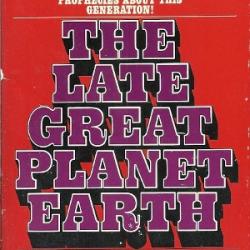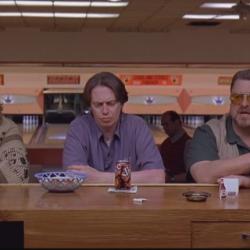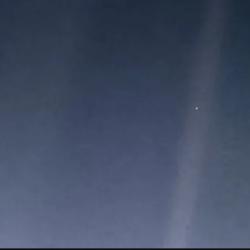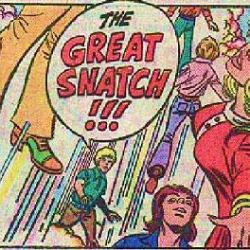Nicolae: Rise of the Antichrist; pp. 200-238
The mistakes in these books are large and they are many. They’re the sort of thing that can clothesline a reader, smacking them clear off the page and out of the story. And yet, for millions of readers, those mistakes don’t seem to have diminished their enthusiasm for the series. Those millions of readers don’t even seem to have noticed these many huge mistakes.
It’s tempting to blame those readers for that. How can they overlook so many contradictions, so much botched geography, so many continuity failures and outright factual errors? Chicago gets attacked with nuclear weapons, then a few pages later, Buck Williams jogs down the streets of downtown Chicago. O’Hare International Airport is destroyed, so Buck reschedules his flight out of Milwaukee, where flights and flight schedules are unaffected by the nearby calamity. Three books into the series and readers still can’t be sure whether there is a single one-world government in which the Antichrist reigns supreme, or whether national governments and jurisdictions remain. Every scene that unambiguously indicates one or the other is followed by another scene that unambiguously indicates the opposite. The same with the supposed post-Rapture global crime wave.

The U.N. is not a diplomatic agency in this book, but an executive government that operates as a planetary federation of nations. Manhattan is 50 miles long, the Jordan is a deep river with boat traffic, and when World War III begins, major news organizations close their offices and send everybody home early, while luxury car dealers stay open, patrolling their sales floors hoping for walk-ins.
Oh, and also this: Every single child of every single parent on Earth disintegrates in a split second, but within a few days, no one ever remembers those children even existed or mentions them ever again. The sudden, inexplicable disappearance of more than a billion children has no emotional, cultural, economic or religious effect on the world.
In the last couple of installments, we’ve discussed another howling continuity failure here in the pages of Nicolae. We’re working through a plodding subplot in which Buck Williams and his friend Tsion Ben-Judah are trying to escape out of Israel, where Tsion has been framed for the murder of his family. They are desperate to cross the border and get out of Israeli jurisdiction, back into the relative safety of the “Global Community.” That may be a worldwide dictatorship run by the Antichrist himself, but at least there Tsion isn’t wanted by the police.
Yet when the authors give us the old standard suspenseful-traffic-stop scene, they get the countries and jurisdictions backwards. Buck ends up trying to fast-talk his way out of trouble with a “Global Community” cop — a guy from the country he’s fleeing to rather than from the country he’s fleeing from.
That’s a pretty major screw-up, and it ruins the logic of the entire subplot. If the GC cops are looking for Tsion, then it makes no sense for Buck and his friend to be trying to escape into the GC.
So how was it possible for those millions of Left Behind fans to read that scene and not notice what an utter mess the authors have made of it?
But then again, overlooking the plot contradictions in this scene isn’t quite as troublesome as the way those millions of good Christian readers seem to have also overlooked the nasty anti-Semitism of this whole escape-from-Israel subplot. These chapters in Nicolae are all based on the premise that the Israeli government, being Jewish, makes it a matter of policy to arrest and/or murder in cold blood anyone who converts to evangelical Christianity. Tim LaHaye and Jerry Jenkins are trying to give us a Hitchcockian thriller based on the ancient blood libel — the assertion that Jews kill Christians.
So I suppose if you’re the type of reader who will blithely swallow such a hateful inversion and perversion of history and all the twisted logic of LaHaye & Jenkins’ anti-Semitism, then also swallowing a bunch of continuity lapses, factual errors and plot contradictions shouldn’t be too hard.
But here’s the thing: I can’t judge any of those millions of readers too harshly, because the more time I spend with these books, the more I realize that there are just as many huge, gaping plot holes, contradictions, factual errors and bigoted assumptions that I’ve missed too.
And, again, these are not small mistakes. They’re massive failures, impediments and impossibilities — obstacles that ought to be insurmountable for any reader trying to get through these pages. Let me give you two examples.
The first is from page 213:
Night was falling. Buck felt all dressed up with nowhere to go. He borrowed a map from Michael and carefully studied it, looking north and south along the waterways that divided Israel from Jordan. If only there were a clear water route from the Jordan River or Lake Tiberius to the Mediterranean!
Did you catch that? I missed that the first time through. The clichés of the first two sentences there lulled me into a half-doze, and the deliberate geographic confusion of the final sentence overshadowed the accidental geographic confusion in the sentence before it. Here it is again:
He borrowed a map from Michael and carefully studied it, looking north and south along the waterways that divided Israel from Jordan.
Way back in the early chapters of Book 1, we learned that Israel has expanded, absorbing much of the territory of its former neighbors. (In these books, the Palestinians, like all the world’s children, simply vanish and are never mentioned again.) But we never get a clear sense of what Israel’s new boundaries might be — not until now. Here we learn that the westernmost border of Jordan still exists as the easternmost border of Israel.
That border is, of course, the Jordan River itself.
Here in this scene Buck Williams is studying a map, seeking some water-route that might lead him safely out of Israel. He is studying that map in Michael’s hideout — some three miles east of the Jordan River.
Michael’s hideout was in Jordan, not Israel. Or, I guess, it was in that portion of the Global Community that was formerly known as Jordan. All that plotting and praying about trying to find some way to get Tsion out of Israel — that all took place outside of Israel. Step 1 in Buck and Michael’s master plan to smuggle Tsion out of Israel involved hiking back to the river and smuggling the ex-rabbi back into Israel.
That’s hilarious, but the weird thing is that I didn’t even notice that the first several times I read these chapters. How did I miss something like that?
Here’s another big mistake in these chapters that I initially missed. Back at the hideout in the formerly Jordanian part of the Global Community, Michael and Buck hit on the plan to have Buck drive south, across the Sinai, and into the formerly Egyptian part of the Global Community. This is the same arid wilderness that Moses and the children of Israel wandered in for 40 years after the Exodus, and Michael cautions Buck about driving the beat-up old school bus through the desert:
“I’d stock you with petrol and water. That thing’ll drink more water than it will gasoline any day.”
… “An oil burner?”
“Not as much as water, but yes, I’m afraid so.”
“What’s in the Sinai?”
“You don’t know?”
“I know it’s a desert.”
“Then you know all you need to know. You’ll be jealous of the bus engine and its water needs.”
That last sentence is bewildering. Is Michael saying that Buck will be envious of the bus’ need for water in the desert? Or is he awkwardly warning Buck to jealously watch over the bus’ radiator?
I’m still not sure what that sentence means, but you can see how stumbling over little things like that can distract a reader from the far larger problem in that passage above.
And in the 20 pages that followed, there were more than enough other awkward or puzzling sentences to keep me distracted and unfocused. So I still didn’t notice the problem as Buck and Tsion drove through the desert.
I didn’t even notice when I read this bit, from pages 230-231, in which Buck and Tsion talk as they drive through the sandy wilderness south of Jericho:
“I worry about Chaim Rosenzweig.”
“I wouldn’t worry about him just yet,” Buck said. “He’s still closely identified with Carpathia. Ironically, that’s his protection for now.”
Buck drove cautiously through Hebron, and he and Tsion rode in silence all the way to Beersheba. In the wee hours of the morning, about 10 kilometers south of Beersheba, Buck noticed the heat gauge rising. The oil gauge still looked OK, but the last thing Buck wanted was to overheat. “I’m gonna add some water to this radiator, Tsion,” he said.
Do you see what it was I somehow missed the first time around?
Those of you who haven’t read the books and are just following along with this series here will be forgiven for not remembering who Chaim Rosenzweig is, because we first met him early in Book 1 and we covered that bit here more than 10 years ago.
We met Chaim in the very first Buck Williams scene, on page 6 of Left Behind. Rosenzweig was a Nobel prize winner, a botanist who had invented something that let him turn one thing into another thing so successfully that the first thing no longer existed.
That first thing? It’s what Buck and Tsion are driving through — the Israeli desert. Here’s the relevant passage, from page 8 of the first book:
The humble man called himself a botanist, but he was in truth a chemical engineer who had concocted a synthetic fertilizer that caused the desert sands of Israel to bloom like a greenhouse.
“Irrigation has not been a problem for decades,” the old man said. “But all that did was make the sand wet, My formula, added to the water, fertilizes the sand.”
… Rosenzweig’s formula was fast making Israel the richest nation on earth, far more profitable than its oil-laden neighbors. Every inch of ground blossomed with flowers and grains, including produce never before conceivable in Israel. The Holy Land became an export capital, the envy of the world, with virtually zero unemployment. Everyone prospered.
I read that. I knew that. I remembered that. If we were playing Left Behind Trivia Quiz and the question was “What did Rosenzweig’s formula do?” or “What became of Israel’s deserts after Rosenzweig’s invention?” I would have gotten those questions right.
And yet I was dozens of pages into my umpteenth reading of Buck’s escape across the Israeli desert before it struck me that everything about this scene is wrong. In these books, the Sinai isn’t a desert — it’s a lush “greenhouse” in which “every inch of ground blossomed with flowers and grains.” (Meaning, I suppose, poppies and hemp, if that “richest nation on earth” bit is to be believed.)
I think the awfulness of these books is so massive in scope and in scale that readers just get overwhelmed and washed away in the current, losing any footing that might allow them to take a stand and register all of these wild and wailing contradictions. If, for example, you were watching the movie Titanic and you saw some extra in the background talking on a cell phone, that mistake would leap off the screen, jarring you out of the movie and out of the story itself. James Cameron’s meticulous attention to detail in every other aspect of the film would have made such a mistake stand out in stark relief. Heck, we’d probably have noticed — and complained — if there’d been an extra in the background with a hairstyle from 1913.
But here in Left Behind world, there’s nothing but mistakes and contradictions and continuity errors. They all blend together with nothing to provide the contrast that would allow readers to get their bearings.
There’s also something too staggeringly incomprehensible about some of these mistakes. They’re just too big for us to handle. Think again of that doozy about the missing children. If we were watching some literary drama like Rabbit Hole, about a young couple’s grief over the tragic loss of their child, we would be focused enough to notice any instance where the characters deviate from that sense of grief and loss. But here — with billions of parents blithely ignoring the loss of their children, such focus becomes impossible to maintain.
That one mistake resonates on every page of every book in this series. There isn’t a single paragraph in any of these books that is not in some way wrong — in tone, substance, character, plot, theme, “prophecy,” theology, politics, economics — due to that one mistake. It’s all too vast for any reader to keep track of. For a while I tried by using as a bookmark a 3-by-5 index card on which I had written “These people all just lost their children. All of them.” But then the only way to keep turning pages was to get rid of that bookmark.
And just as the sheer number of parents and children made it impossible to keep track of that one mistake, the sheer number of other mistakes made it impossible to keep track of anything.
I guess what I’m saying, then, is that I can’t blame the millions of fans of these books for failing to notice any one particular mistake or error in the series. That’s understandable and probably inevitable — like failing to notice a single poppy in that sea of flowers in The Wizard of Oz. But I think we can, and should, blame those fans for failing to notice that the entire series is nothing but flowers — nothing but a vast narcotic sea of poison poppies, an endless field of continuity errors, plot holes, contradictions, factual errors, strained exegesis, inhuman behavior and sheer nonsense.
I’m sure that statement will seem like a rude accusation to those fans, so if any of you are reading this, please, by all means, prove me wrong. Go back to your beloved books and re-read them, angrily watching out for any such mistakes. Go back and re-read them all determined to prove me wrong. Get your hackles up and re-read them defensively. If you get mad enough, you might just be able to see what you weren’t able to see the first time around.












